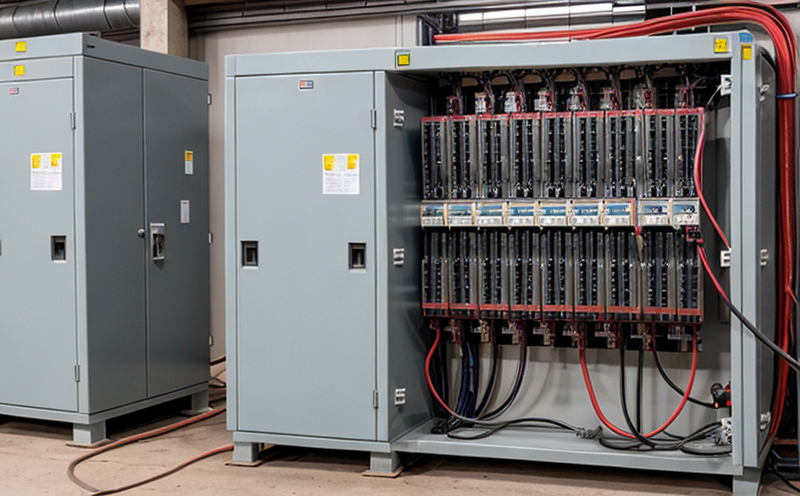UL 1562 Dry-Type General Purpose Transformer Safety Testing
The UL 1562 standard provides stringent guidelines for ensuring the safety of dry-type general purpose transformers. These transformers are widely used in power distribution systems due to their compact design, high efficiency, and low maintenance requirements. The testing process under this standard is crucial as it ensures that these transformers meet strict electrical and mechanical performance criteria.
The UL 1562 test procedures include a comprehensive battery of tests designed to evaluate the transformer's insulation integrity, thermal stability, and overall safety features. This includes dielectric strength tests, short-circuit withstand capability testing, and temperature rise tests under specified conditions. The transformers are subjected to rigorous environmental stress tests such as cold storage, humidity conditioning, and high-temperature storage to ensure they perform reliably in diverse operational environments.
The testing process is meticulously planned to simulate real-world operating scenarios. For instance, the short-circuit withstand capability test assesses the transformer's ability to safely handle sudden surges of electrical current without sustaining damage or compromising safety. This test involves applying a voltage far exceeding the nominal rating and monitoring the response of the transformer.
The temperature rise tests are conducted under load conditions that simulate actual usage scenarios, ensuring that the transformer can operate continuously without overheating. These tests are critical in determining the transformer's thermal stability and its compliance with safety standards. Compliance with these standards is not just a regulatory requirement but also ensures the reliability of power distribution networks.
The UL 1562 testing process is highly technical, involving precise control over environmental conditions, voltage application, and monitoring systems to ensure accurate results. The transformers are tested using state-of-the-art equipment that can provide real-time data on performance parameters. This data is then analyzed to determine compliance with the specified standards.
The UL 1562 testing process is not only about safety but also about ensuring product quality and reliability. By adhering strictly to these tests, manufacturers can ensure that their transformers are safe for use in power distribution systems. This standardization helps in maintaining high levels of electrical safety and reliability across the industry.
The UL 1562 testing process is designed to be rigorous yet practical, ensuring that the transformers meet all necessary standards while remaining functional and efficient. The comprehensive nature of these tests ensures that any potential issues are identified early in the manufacturing process, allowing for corrective actions before the product reaches the market.
Why It Matters
The importance of UL 1562 testing cannot be overstated, especially within the context of power and utilities. These transformers serve as critical components in ensuring stable and safe electrical distribution networks. The tests under this standard are essential for several reasons:
- Consumer Safety: Ensuring that transformers meet strict safety standards helps prevent electric shocks and other hazards.
- Reliability: By adhering to these rigorous testing protocols, manufacturers can ensure that their products will perform reliably under various conditions.
- Compliance: Meeting UL 1562 ensures compliance with international safety standards, which is crucial for global trade and market access.
- Quality Assurance: The comprehensive nature of these tests provides a robust framework for quality assurance that enhances product reputation and customer trust.
In the context of power distribution systems, transformers are not just components but integral parts that ensure the smooth flow of electricity. Any failure in this critical infrastructure can lead to significant disruptions and safety hazards. By adhering to UL 1562 testing protocols, manufacturers play a vital role in maintaining the integrity and reliability of these systems.
Quality and Reliability Assurance
The quality and reliability assurance processes associated with UL 1562 testing are multifaceted. These processes ensure that each transformer meets the stringent requirements set by this standard:
- Inspection: Before testing, transformers undergo a thorough inspection to identify any potential defects.
- Calibration: All test equipment is calibrated to ensure accurate and consistent results.
- Data Analysis: Comprehensive data analysis is conducted post-testing to validate compliance with the standard.
- Documentation: Detailed documentation of all testing procedures and results is maintained for quality assurance purposes.
The use of advanced testing equipment and methodologies ensures that the transformers are subjected to a wide range of conditions, simulating real-world scenarios. This approach helps in identifying any weaknesses or areas for improvement early on in the manufacturing process. The robust documentation process ensures traceability and accountability throughout the production cycle.
Use Cases and Application Examples
| Use Case | Description |
|---|---|
| Data Centers | UL 1562 testing ensures that transformers in data centers provide reliable power supply, critical for operations. |
| Residential Substations | Testing transformers used in residential substation systems ensures safety and reliability of home electricity distribution. |
| Rural Power Networks | In rural areas with limited infrastructure, ensuring transformer safety is paramount to prevent outages and hazards. |
| Industrial Plants | Transformers in industrial plants must be reliable and safe. UL 1562 testing ensures this critical requirement. |
The transformers used in these applications are subjected to a variety of tests that simulate real-world conditions. For example, data centers rely heavily on uninterrupted power supply, making the safety and reliability of transformers a top priority. The same goes for residential substation systems where any failure can lead to significant disruptions.





